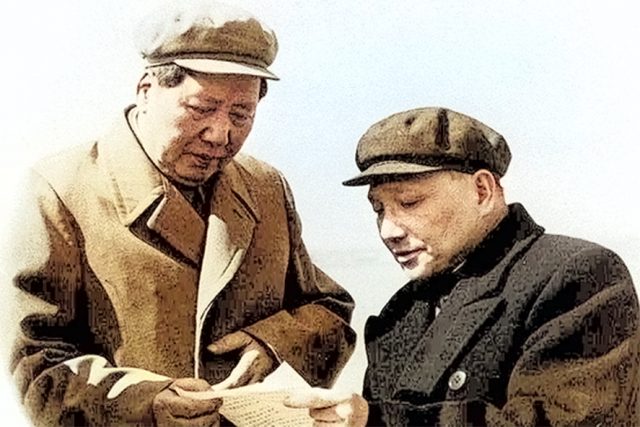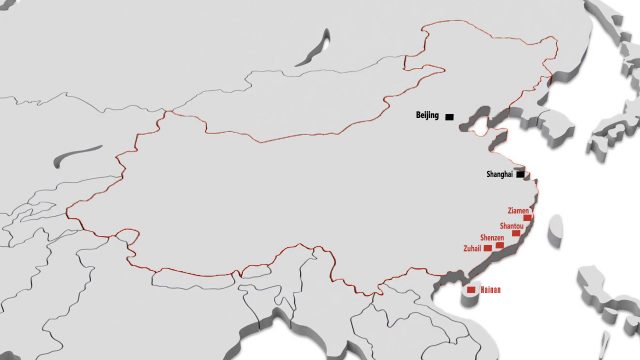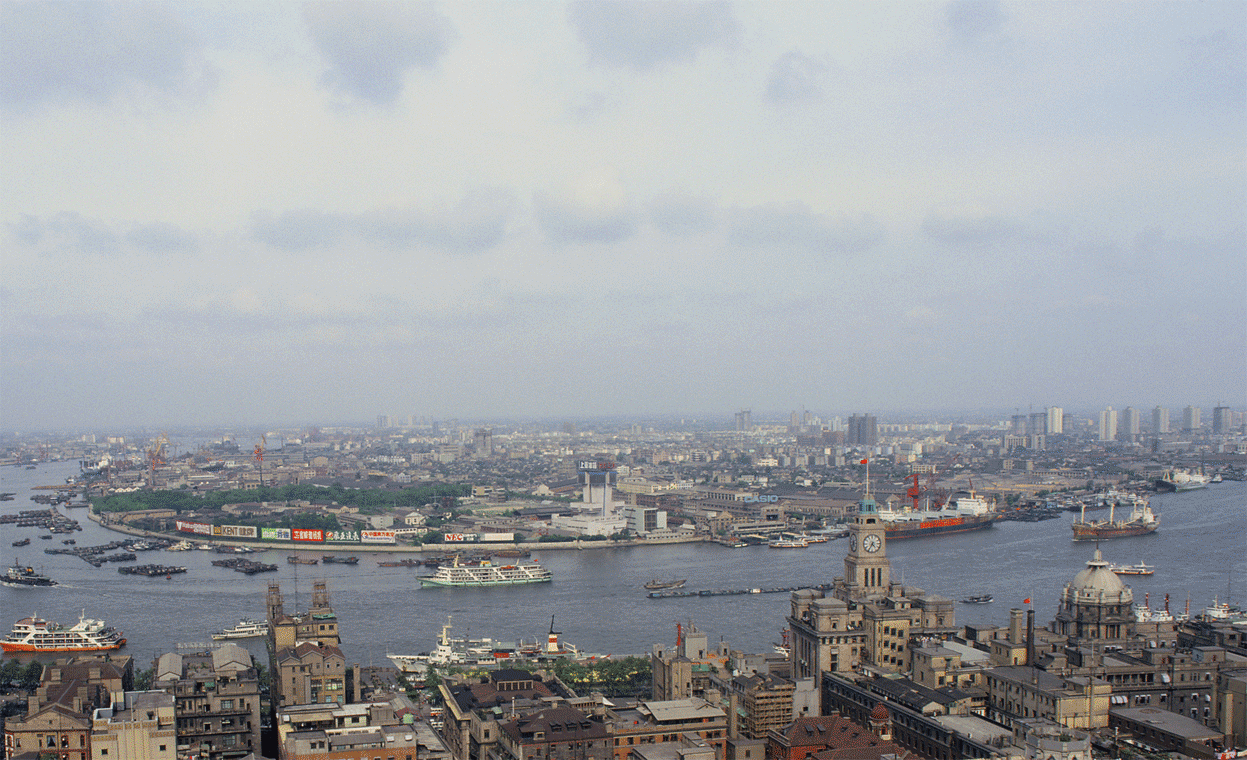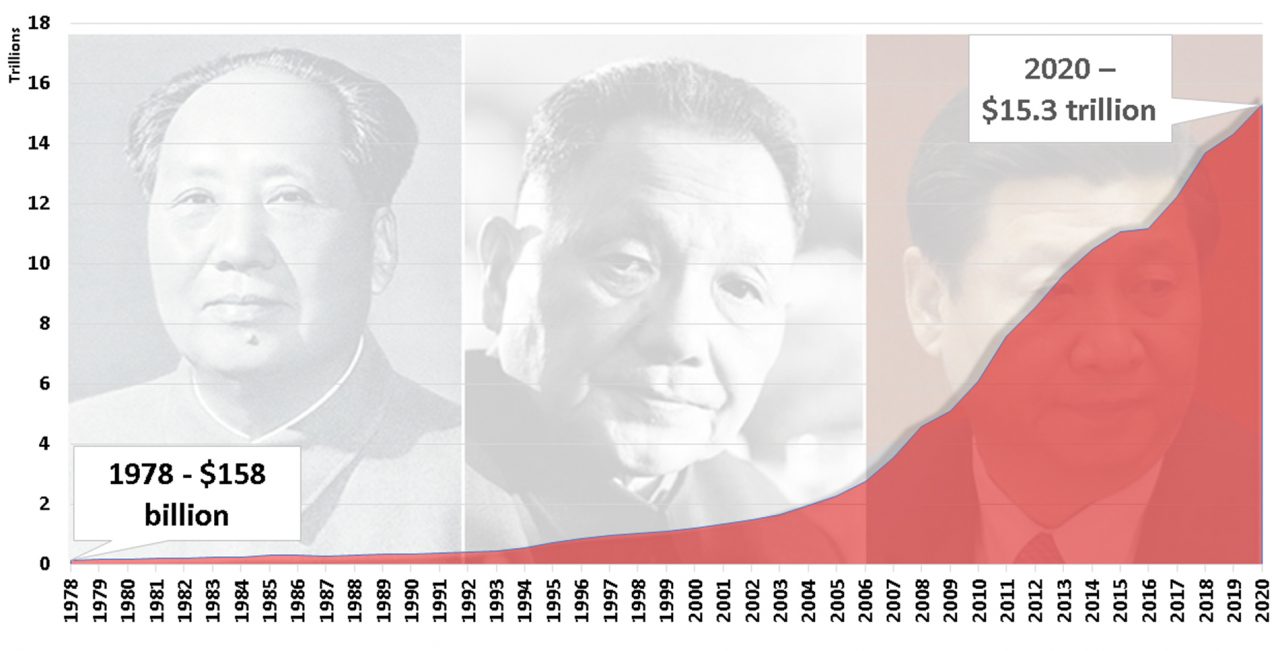As the Chinese Communist Party (CCP) celebrates its centenary, the party’s stewardship of the national economy is taking centre stage in the celebrations. China today is a very different place to where it was at the end of the 20th century, and all of this is down to its rapid economic development that took-off from 1979. China’s rapid economic development is the major development of the 21st century and it continues to gain global attention, including US policy makers. This economic success story now makes the CCP a key part of China’s four millennia civilisation.
When Deng Xiaoping became China’s paramount leader in 1978, he took over a country that suffered from numerous problems. Whilst World War 2 was firmly in the past, in the 1970s China was still stuck in the 1950s. It lacked technological development and relied upon capital intensive industries. Production of consumer goods was low and basic goods such as bicycles, clothing and electric fans were not available to most Chinese citizens and were rationed. This situation was largely due to the CCPs self-destructive policies such as the Great Leap Forward and attempts to turn the country into a communist state. China’s GDP in 1976 was a mere $153 billion, whilst it possessed the world’s largest population of 930 million. Spain and Holland – who are the size of Chinese cities – had larger economies. Over 90% of China’s population was in poverty. What Deng and his reformists inherited from Mao Zedong was a country beset with disenchantment with the Communist Party and institutional disorder resulting from the chaotic policies of the Mao era.

Due to the satiation of China, the reformists in the CCP were of the view that developing China economically was not just an aspiration but a necessity. A comprehensive analysis of China’s state of affairs was undertaken by technocrats from the CCP. The analysis was presented at the 3rd Plenary Session of the 11th Central Committee of the Communist Party of China in 1978. It concluded that the prior efforts to develop China had been failures. Mao’s theory of continued revolution under socialism needed to be abandoned and it proposed a new comprehensive policy for China called the “Four Modernizations” of 1) industry, 2) agriculture, 3) national defence and 4) science and technology. The new comprehensive policy was based on a number of underpinnings:
- The realisation that China possessed many strengths needed to become a global superpower. She had the agrarian land to be self-sufficient in her food supply. The sheer size of China’s population gives it the ability to become economically independent. If managed properly, such strengths combined could give China the financial ability to develop her armed forces. Through which the country could then become an all-round global superpower.
- The realisation that China would never achieve her potential if she did not increase her knowledge base. If China ever wanted to challenge the then foremost powers of the day, America and the Soviet Union, the Chinese workforce would need to make ‘great leaps forward’ in both technical and managerial knowledge.
- The realisation that her population, and in particular the growth of her population, could become the nation’s Achilles heel. If China’s population growth was not matched with economic growth and employment then the resulting mass unemployment would cause mass poverty, civil unrest and a revolt against the rule of the Communist Party.
All of this was translated into policy in 1979 and saw the birth of China’s ‘open door’ economic policy that led to rapid economic development. China’s ‘open door’ economic policy gradually opened up the national economy to foreign companies in a process that was well controlled by the Communist Party
Special Economic Zones (SEZ)
China’s population was for long seen as a liability due to her size and the poverty many were experiencing. This also meant China possessed something no other country had: abundant labour. In 1980, Beijing created the first Special Economic Zone (SEZ) in the coastal Guangdong and Fujian provinces, designed to attract foreign investment in low-end manufacturing by offering cheap labour and a variety of tax and other incentives. Success in southern cities saw Beijing expand economic reforms, first to the Yangtze River Delta area and later to cities along the Yellow and Bohai seas. For most of the last 40 years, these coastal clusters acted as Beijing’s experimental interface with the outside world.

China’s SEZs created immense wealth for the country, they were all constructed on China’s eastern coast so all manufacturing that came off the production lines were placed on ships as cargo and exported to the world. The coastal region over the decades came to be interlinked with the global economy. To make herself competitive China enticed foreign companies to bring their operations — and with them, their capital and technology — to China. Foreign direct investment (FDI) into China soared as Beijing welcomed foreign businesses into the country. Under the resulting arrangement, China’s exports consisted mainly of foreign-branded products, rather than the domestic goods that Japan and South Korea grew to rely on from firms such as Toyota and Samsung. Like Japan and South Korea, China gradually moved up the value chain with her industrial manufacturing, progressing from light industry, such as textile production, through to electronics and on to high-tech assembly.
To attract foreign companies China needed to develop the infrastructure to link the vast country and allow manufacturers to trade. Roads, ports, power plants and telecommunication networks were constructed in order for manufacturers to move their production facilities to China. In the 1980s, China also launched major efforts to build dams, irrigation projects and highways. The “Food-for-Work” programme, which offered free meals to workers, promoted highway construction in rural areas. Between 1994 and 2000, some 26,100 miles – about 745 miles a day – of rural highways were built a year. In 1979 China had a mere 33,000 miles of rail, in 2016 this exceeded 77,000 miles, the longest high speed rail network in the world.
On the eve of the open and reform era in 1978 only 18% of China’s population was living in urban cities. This share had remained static since the 1950s. From 1978 to 2013 China’s urban population increased from 172 million to 731 million. Today, China’s urban population is 810 million – 58% of her total population. To put these numbers into perspective, China has had to build infrastructure, properties, schools and whole towns for 810 million former farmers who moved to cities. China needed to construct a New York and Boston every year for 35 years with the urban population growing by 16 million every year. What China achieved is unprecedented, it created 25 of the world’s 100 largest cities, today China has 183 cities with populations in excess of one million, 15 are megacities, which are defined as having populations in excess of ten million.

State Driven Capitalism
At the heart of China’s economic development has been the nation’s banking system. In China the government used the national banking system to serve the Communist Party’s objectives. The nation’s large savings were funnelled through banks to firms through subsidised rates. In order to qualify for such loans, firms were required to maintain high employment (in order to maintain social cohesion), rates of return on capital, building brands, customer service and profit played no part in this process. Anyone who wanted to start a business, could get access to subsidized loans and this multiplied China’s economic growth. These loans did not look at the ability of the debtor to repay, so as long as they created jobs the CCP ensured loans were made available.
Some 160 large State-Owned Enterprises (SOEs), provided the key inputs from utilities, heavy industries and energy resources that facilitated the private sector. The aggressive outward investment strategy, driven by SOEs and state banks with massive pools of cash allowed China to spread across the world looking to expand markets, employ services and buy up resources. Whilst the role of SOE has reduced today, up until the mid-2000s they played a key role in driving China’s economy.
To make Chinese goods more attractive than Japanese and German goods, the Chinese government controlled the value of the exchange rate of its currency with the world, rather than let it float freely. China kept the value of her currency artificially low, which made it cheaper to purchase consumer goods – far cheaper for the world than anyone else. By China undercutting the world, aside from keeping Chinese factories open, this also meant most Chinese citizens had a job. When Chinese citizens have jobs this deals with domestic social unrest which has long plagued the country. Chinese factories made little profits on the goods they exported, due to the low exchange rate the potential profit is lost. According to the Chinese Ministry of Finance, Chinese profits on their exports are about 1.7%.
‘Black or White Cat?’
Deng Xiaoping famously stated: “I don’t care if the cat is black or white, so long as it catches mice.” This meant for Deng if a system or policy works, it should be used. His reforms for China were gradual, and the CCP did not follow any ideology for economic development from 1978. Reform in China was driven by pragmatism and undertaken slowly to manage change. China focused on export-oriented growth and slowly opened certain sectors of its economy to foreign companies. All the major reforms were the result of a process of trial and error on a limited scale. Successful experiments were then scaled up and rolled out across the country. Thus, the establishment and success of four Special Economic Zones (SEZ) in the 1980s, led to them being rolled out across the country.
China today has an economy with many elements of capitalism, but the CCP adopts what works for the country, rather than looking to be an ideological country. China’s political system has only one political party – the CCP. China uses nationalism and history to unite the country and in her foreign policy she doesn’t advocate any values, she just wants economic deals, investment and markets.
…reforms for China were gradual, and the CCP did not follow any ideology for economic development from 1978. Reform in China was driven by pragmatism and undertaken slowly to manage change….China today has an economy with many elements of capitalism, but the CCP adopts what works for the country, rather than looking to be an ideological country
After nearly two centuries, China has developed an economy which allows her to fulfil the basic needs of her large population as she now has an economy which can achieve this, something that has been sorely lacking for the last 150 years. China’s rapid economic rise has now created a new challenge, one that shifted China out of what had been a near self-reliant capability and into one that left China vulnerable to international involvement. China’s economic development has now made her dependent on foreign trade routes, resources and foreign markets.

China’s economic success has been built upon importing raw materials, commodities and energy from the world. She has an economy that is based on adding value to this by converting them into exportable goods to the rest of the world. China is dependent on the global economy, global markets, sea routes and infrastructure. China must secure her vulnerable supply lines through expanding her military presence and extend her international presence. This naturally brings her into conflict with the global superpower.

